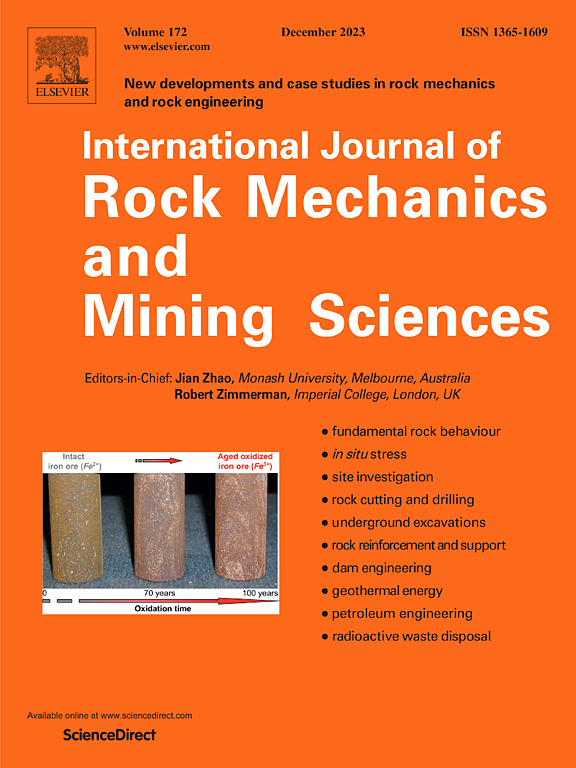真三轴动力冲击下煤的力学性能及宏细观损伤演化试验研究
IF 7
1区 工程技术
Q1 ENGINEERING, GEOLOGICAL
International Journal of Rock Mechanics and Mining Sciences
Pub Date : 2025-04-30
DOI:10.1016/j.ijrmms.2025.106142
引用次数: 0
摘要
在深部煤矿开采过程中,由于动载荷的作用,煤体不可避免地受到三维应力的破坏。这种破坏使煤在静荷载作用下极易失稳破坏,对工程安全构成威胁。因此,研究真三轴动力损伤对煤体的影响至关重要。本研究旨在阐明煤在真三轴动力冲击后的力学性能及损伤机理。对煤样进行了不同偏应力和冲击速度下的真三轴动冲击试验。在冲击前后分别进行核磁共振(NMR)试验,检测孔隙结构变化,并对冲击煤样进行单轴准静态加载试验。结果表明:随着偏应力的增大,煤的动弹性模量、动峰值应力、弹性模量和单轴抗压强度减小,动峰值应变、应变率、静峰值应变和裂纹压实应变增大;较高的冲击速度提高了动态力学参数,但同时降低了静态力学特性。随着偏应力和冲击速度的增大,孔隙内部孔隙数量增加,微孔比例下降,中宏孔比例上升,孔隙结构的多重分形维数减小,孔隙连通性提高,渗透率增加,损伤程度加剧。本研究阐明了煤体内部孔隙结构损伤导致宏观力学性能退化的基本机理,并提出了基于孔隙度演化的煤体宏观力学性能退化过程的定量表征。结合这一损伤机制,建立了一种新的统计损伤本构模型,该模型准确地描述了煤在真三轴动态冲击和再加载条件下的力学行为。这些发现加深了对复杂应力状态下煤炭复杂损伤演化的理解,为深部开采作业的安全控制和稳定性评估提供了重要见解。本文章由计算机程序翻译,如有差异,请以英文原文为准。
Experimental study on mechanical properties and macro–mesoscale damage evolution of coal following true triaxial dynamic impact
During deep coal mining, the coal mass inevitably suffers damage under three-dimensional stress due to dynamic loads. This damage renders the coal highly susceptible to instability and failure under static loads, thereby posing a threat to engineering safety. Therefore, it is crucial to investigate coal affected by true triaxial dynamic damage. This study aims to elucidate the mechanical properties and damage mechanisms of coal after true triaxial dynamic impact. True triaxial dynamic impact tests were conducted on coal specimens under varying deviatoric stresses and impact velocities. Nuclear magnetic resonance (NMR) tests were performed before and after impact to examine changes in pore structure, followed by uniaxial quasi-static loading tests on the impacted coal samples. The results indicate that as deviatoric stress increases, the coal's dynamic elastic modulus, dynamic peak stress, elastic modulus, and uniaxial compressive strength decrease, while dynamic peak strain, strain rate, static peak strain, and crack compaction strain increase. Higher impact velocities elevate dynamic mechanical parameters but simultaneously deteriorate static mechanical characteristics. Additionally, with increasing deviatoric stress and impact velocity, the number of internal pores rises, the proportion of micropores declines, the proportion of meso-macropores rises, the multifractal dimension of the pore structure diminishes, pore connectivity improves, permeability increases, and damage severity intensifies. This study elucidates the fundamental mechanism by which internal pore structure damage in coal leads to the degradation of macroscopic mechanical properties and proposes a quantitative characterization of this deterioration process based on porosity evolution. By incorporating this damage mechanism, a novel statistical damage constitutive model has been developed that accurately describes the mechanical behavior of coal under true triaxial dynamic impact and reloading conditions. These findings deepen the understanding of the complex damage evolution of coal under intricate stress states, offering critical insights for safety control and stability assessment in deep mining operations.
求助全文
通过发布文献求助,成功后即可免费获取论文全文。
去求助
来源期刊
CiteScore
14.00
自引率
5.60%
发文量
196
审稿时长
18 weeks
期刊介绍:
The International Journal of Rock Mechanics and Mining Sciences focuses on original research, new developments, site measurements, and case studies within the fields of rock mechanics and rock engineering. Serving as an international platform, it showcases high-quality papers addressing rock mechanics and the application of its principles and techniques in mining and civil engineering projects situated on or within rock masses. These projects encompass a wide range, including slopes, open-pit mines, quarries, shafts, tunnels, caverns, underground mines, metro systems, dams, hydro-electric stations, geothermal energy, petroleum engineering, and radioactive waste disposal. The journal welcomes submissions on various topics, with particular interest in theoretical advancements, analytical and numerical methods, rock testing, site investigation, and case studies.

 求助内容:
求助内容: 应助结果提醒方式:
应助结果提醒方式:


